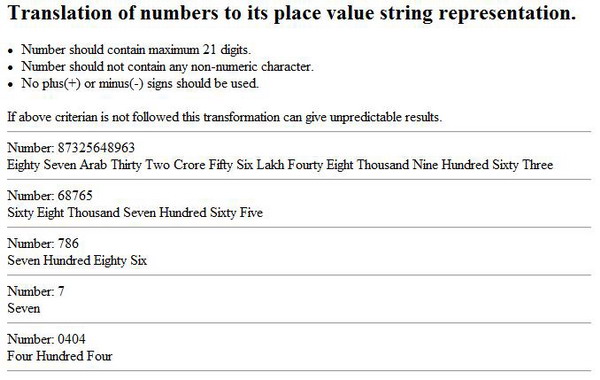
Introduction
We all have seen many applications written in different languages to transform numerical data to its equivalent place value representation. For example: 123 represented as 'One Hundred Twenty Three'. I am learning XSLT, and wrote this application to perform this transformation from XML to HTML numeric to place value translation. This transform file uses many features of XSLT like in-built methods for string manipulation, formatting, and number conversion.
Background
People unfamiliar with India’s traditional numbering system may find this challenging. The system used in India, Pakistan, and Bangladesh is based on a unique grouping of two decimal places, rather than three decimal places common in the West. During business dealings in India, people are likely to come across the numerical terms Arab, Crore, and Lakh (see table below), although the higher numbers listed are rarely used. These more common words are often used in combination, e.g., one Lakh Crore, which is 1012, or one trillion. The terms Padma and Kharab are sometimes used in Hindi.
India’s unique number system
| Term Figure | No of zeros | Western system (short-scale) |
| Lakh (lac) 1,00,000
| 5
| 100000 (100 thousand)
|
| Crore 1,00,00,000
| 7
| 10,000,000 (Ten million)
|
| Arab 1,00,00,00,000
| 9
| 1,000,000,000 (One billion)
|
| Kharab 1,00,00,00,00,000
| 11
| 100,000,000,000 (100 billion)
|
| Neel 1,00,00,00,00,00,000
| 13
| 10,000,000,000,000 (10 trillion)
|
| Padma 1,00,00,00,00,00,00,000
| 15
| 1,000,000,000,000,000 (One quadrillion)
|
| Shankh 1,00,00,00,00,00,00,00,000
| 17
| 100,000,000,000,000,000 (100 quadrillion)
|
| Maha-shankh 1,00,00,00,00,00,00,00,00,000
| 19
| 10,000,000,000,000,000,000 (10 quintillion)
|
Source
Using the Code
Make your XML document as in the specified format given below. Put a stylesheet reference to your XML and open the XML in a web browser (in this XML, # represents a digit):
="1.0"="utf-8"
="text/xsl"="TransformNumber.xslt"
<numbers>
<number>#########</number>
<number>####</number>
<number>####</number>
<number>#</number>
<number>###########</number>
<number>#####</number>
</numbers>
Conversion Algorithm
(1234 -> 10234)
(10234->010234)
value:01 place:3 evaluates to 'One Thousand'
value:02 place:2 evaluates to 'Two Hundred'
value:34 place:1 evaluates to 'Thirty Four'
resulting in the string: 'One Thousand Two Hundred Thirty Four'.
- Read each number in the XML and check if it contains a hundred place value. If yes, insert a '
0' character at the fourth place in the string from the right position. (This step handles the exception since only a hundred place value is evaluated as a single digit in the Indian place-value number system; the rest of the places have paired values.) - Check if the
string has an odd number of characters after Step 1. If yes, prefix the string with a '0' character. (This step makes sure that the string contains an even number of characters; thus the string will be split into digit pairs later on and translated to its string equivalent.) - For each pair, call the translator with the pair value and its position in
string. The position is determined by dividing the length of the string by 2.
Translator Algorithm
Each pair contains two digits.
(34 -> 3 + '0' -> 30 -> Thirty)
(34 -> 4 -> Four)
(3 -> 3-1 -> 2 -> Thousand)
- Separate the first digit and postfix it with a '
0' character. Translate it into its equivalent string representation. Don't do anything if the value is zero. - Take the second digit and put its corresponding string representation. Don't do anything if the value is zero.
- Take the place value and translate it to represent the actual place of this
string pair in the whole number. Don't do anything if the place is zero.
Points of Interest
The XSLT file in this project can help you understand calling recursive templates, and also gives an idea about how to use in-built functions. We can use this as a base and can design our own XSLT for the English number system translation.
